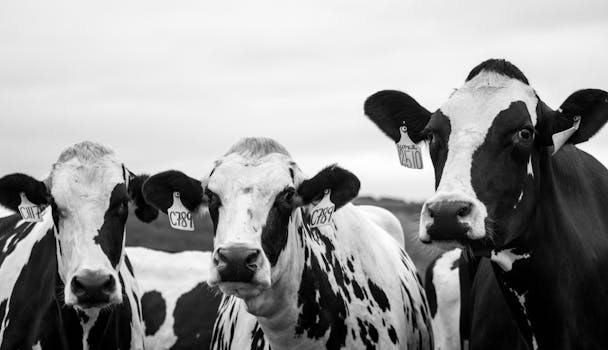
**
UHF Cattle Tagging Mandate Confirmed for 2026: Revolutionizing Livestock Management and Traceability
The livestock industry is on the cusp of a significant technological upgrade. A recent announcement confirms the nationwide implementation of Ultra-High Frequency (UHF) cattle tagging by 2026, marking a pivotal moment in animal traceability and overall farm management. This move, driven by a need for enhanced biosecurity, disease control, and improved market efficiency, will impact every facet of the cattle industry, from ranchers and farmers to processors and consumers. This article delves into the implications of this landmark decision and explores what it means for the future of cattle farming.
Why the Shift to UHF Cattle Tags?
The current system relies on visual identification and less sophisticated tagging methods, often leading to inaccuracies, inefficiencies, and difficulties in tracking animals throughout their lifecycle. UHF technology offers a superior solution by providing:
- Improved Accuracy: UHF tags offer significantly enhanced readability compared to traditional tags, minimizing errors in identification. This is crucial for accurate record-keeping, disease tracing, and meeting regulatory compliance.
- Enhanced Traceability: The ability to quickly and accurately scan large numbers of cattle using handheld UHF readers dramatically improves traceability throughout the supply chain. This enhanced visibility will streamline processes, reduce losses, and help in responding to disease outbreaks more effectively.
- Real-time Data Collection: UHF technology facilitates the integration of data management systems, enabling real-time tracking of animal movements, health status, and performance metrics. This data-driven approach can optimize herd management, improve productivity, and reduce costs.
- Biosecurity Enhancement: Rapid identification of infected animals through UHF tagging enables quicker containment of diseases and prevents wider outbreaks, safeguarding both animal health and economic stability.
- Improved Market Access: Many international markets are demanding greater transparency and traceability in their supply chains. UHF tagging helps meet these demands, potentially opening up new export opportunities for cattle producers.
Addressing Concerns Regarding UHF Tagging Implementation
While the benefits are clear, the transition to UHF technology raises some concerns among farmers and ranchers. These include:
- Cost of Implementation: The initial investment in new readers and tags can be significant for some producers. However, government subsidies and phased implementation plans are being considered to mitigate this financial burden.
- Training and Education: Proper training is essential to ensure farmers and ranchers can effectively use the new technology. Extensive educational programs and support services will be provided to facilitate a smooth transition.
- Data Security and Privacy: Concerns about data security and privacy associated with the increased data collection need to be addressed with robust data protection measures. Regulations and protocols will be implemented to ensure data confidentiality and integrity.
The 2026 Deadline: A Phased Approach to Implementation
The 2026 deadline signifies a commitment to widespread adoption, but the implementation will likely occur in phases to allow producers ample time to adapt. This phased approach could involve:
- Pilot Programs: Initial pilot programs will test the efficacy of the technology and address any logistical challenges before widespread implementation.
- Regional Rollouts: The rollout may begin in specific regions or states, allowing for adjustments and refinements before national implementation.
- Financial Assistance Programs: Governmental and industry support will likely be provided in the form of financial aid, grants, and subsidized equipment purchases to help ranchers manage the cost of transitioning to UHF technology.
UHF Tags: A Technological Leap for Sustainable Cattle Farming
The mandatory adoption of UHF cattle tags represents a substantial advancement in livestock management and traceability. While challenges exist, the long-term benefits far outweigh the costs. The increased efficiency, improved biosecurity, and enhanced market access offered by UHF technology will pave the way for a more sustainable and profitable cattle industry.
Key Benefits Summarized:
- Enhanced Traceability: Streamlines supply chain, improves efficiency.
- Improved Biosecurity: Faster disease detection and containment.
- Better Data Management: Enables data-driven decision-making.
- Increased Market Access: Meets international traceability standards.
- Reduced Losses: Minimizes errors and inefficiencies in animal identification.
Future Trends in Cattle Tracking Technology
Beyond UHF tagging, the future of cattle management will likely involve integration with other technologies like:
- GPS Tracking: Real-time location tracking of animals for improved grazing management and theft prevention.
- AI-powered Analytics: Using data analytics and artificial intelligence to predict animal health risks and optimize herd performance.
- Blockchain Technology: Leveraging blockchain for secure and transparent record-keeping throughout the supply chain.
The 2026 UHF cattle tagging mandate marks a significant turning point for the cattle industry. It’s a commitment to modernizing practices, enhancing sustainability, and ensuring the long-term health and prosperity of the sector. While the transition requires careful planning and support, the rewards of improved traceability, enhanced biosecurity, and increased market access will be well worth the effort. The future of cattle farming is undeniably data-driven, and UHF technology is leading the charge.




















